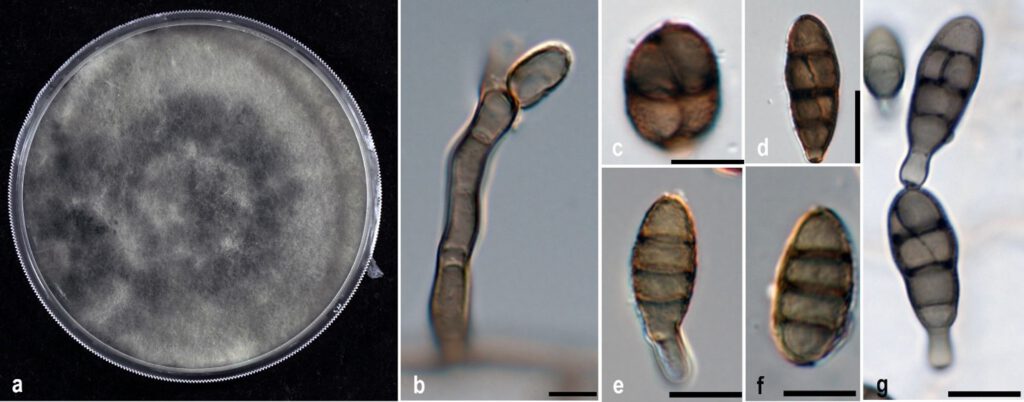Alternaria astragalicola W. Zhao, Q. Ning, & J.Y. Yan, sp. nov
MycoBank number: MB 558425; Index Fungorum number: IF 558425; Facesoffungi number: FoF 10795;
Description
Asexual morph: Hyphae subhyaline to pale olivaceous, branched, smooth, septate. Conidiophores 25–119×2.5–4.5 μm (x̅ =44.6×3.9 μm,n = 10), solitary, simple, straight, or flexuous, pale brown, multi-septate, with a single terminal conidiogenous locus. Conidia 10.5–30×7–12 μm (x̅ =17.1×9.2 μm,n = 50) solitary or in branched chains of 2, straight, clavate to elongated clavate, light brown to dark brown, with a smooth outer wall, some muriform, usually with 2–3 transverse septa and 1–2 longitudinal septa, rounded apex, stalked or stalkless. Sexual morph. not observed.
Culture characteristics – Colonies on PCA attaining 80 mm diam. after 10 days at 25 °C in 12h light and 12h dark, circular, entire-edged, effuse, floccose to woolly, surface pale olivaceous grey near the margin changing to dark green in the centre and reverse olivaceous black.
Material examined: China, Henan Province, Shihe District, from Astragalus sinicus pod, May 2018, Zhao Wensheng and Zhang Guozhen, (JZBH 3180064 holotype), living culture = JZB 3180064.
Distribution: China
Notes: The new strain fits well into the concept of Alternaria. In multi-marker analysis, for Alternaria astragalicola formed a sister clade to A. pseudoeichhorniae (MFLUCC 18–1589) with a 62% ML support (Fig. 11). Morphological comparison between ex type strain of Alternaria pseudoeichhorniae and A. astragalicola revealed different conidiophores and conidial characters. Compared to our strain, A. pseudoeichhorniae have small conidiophores (24.9– 118.8×2.5– 4.5 μm vs 18– 48.5 × 2.5– 6 μm) and larger conidia (10.5– 29.7×6.7–12.1 μm vs 16–30.2 × 5– 13 μm) (Chethana et al. 2019). Alternaria astragalicola have conidia in branched chains of two, while A. pseudoeichhorniae produce conidia in a chain of 2–4 or more.

Fig. x. Alternaria astragalicola (JZBH 3180064, holotype), a Colony on PCA, b. Conidiophore, c–f Conidia, g Conidial arrangement. Scale bars: b–g= 10 µm.
